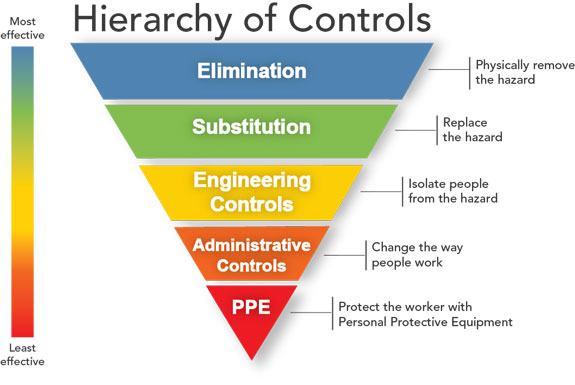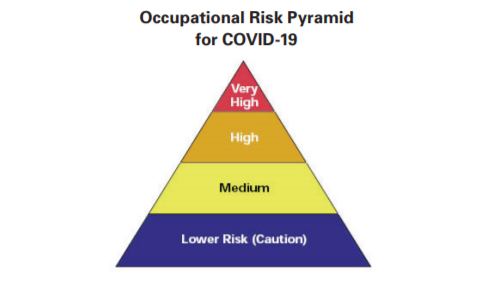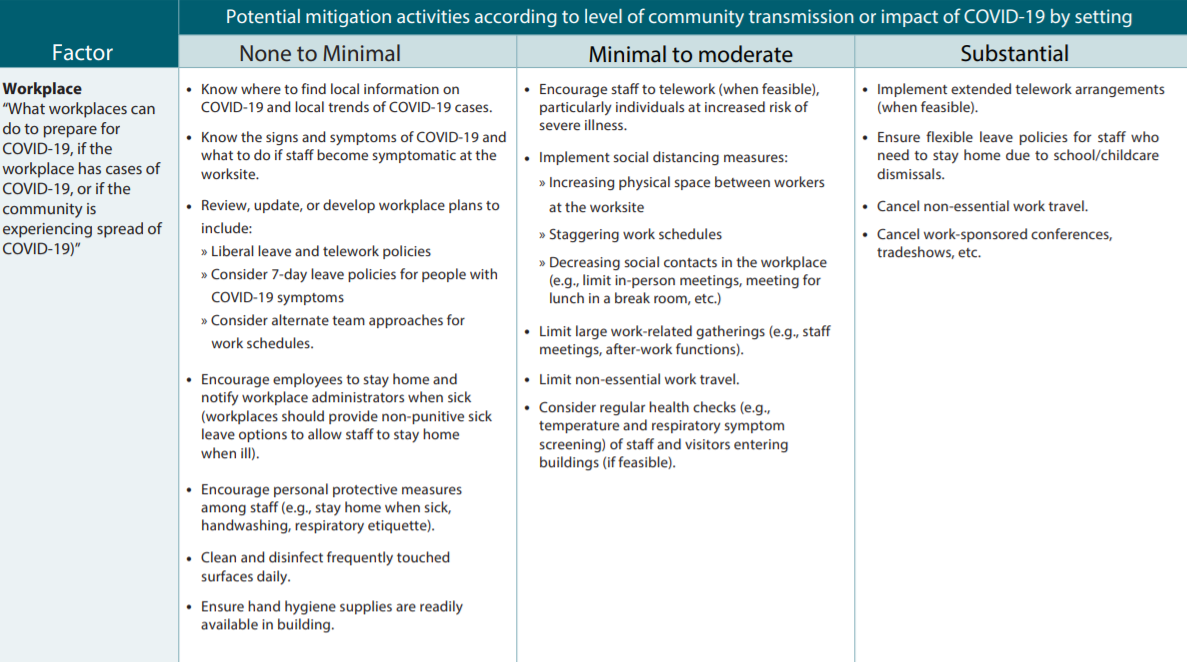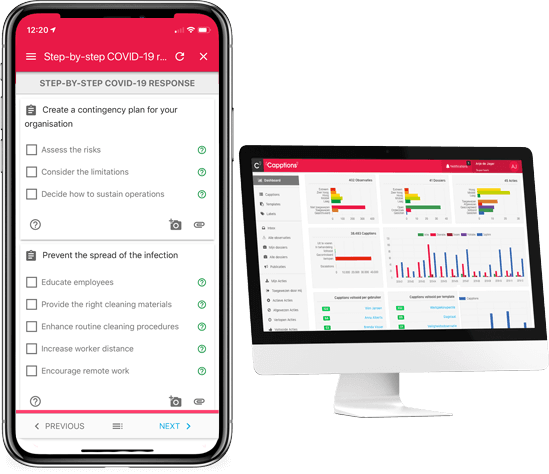We use our own cookies as well as third-party cookies on our websites to enhance your experience, analyze our traffic, and for security and marketing. Please read our Cookies Policy.
COVID-19 Response: Complete Guidelines & Resources for EHS Professionals
By Jonathan Stolk
As the coronavirus pandemic unfolds, it’s becoming more and more important for all of us to step up and stand by our communities. In response to COVID-19, we want to help protect those who are in the front lines of the battle.
Municipalities, first responders, public health organizations, healthcare facilities and all other life-essential services providers will be able to use Capptions for free to:
- Conduct EHS inspections and audits remotely
- Automate business processes with custom forms
- Create custom auditing checklists
- And more…
What can EHS professionals do?
As of March 30th 2020, more than 700,000 cases of COVID-19 have been reported worldwide, about 50% of them being in the EU, the UK and the USA.

There is no doubt that, in one way or another, everyone’s life is severely affected by the coronavirus. People and families are self-isolating. Entire cities and countries have been locked down. Businesses of all kinds are facing unprecedented economic challenges. Unfortunately, various estimates suggest that the pandemic could last for 12-18 more months.
We all have no choice but to accept that the coronavirus may be part of our daily lives for quite some time and adapt. That’s why, as a response to this crisis, many organisations have chosen to enable and stimulate remote work.
But for a large number of roles, the home office is simply not a viable option. In industries such as manufacturing, oil and gas and telecommunications, companies have to continue functioning because, otherwise, normal daily life would be disrupted. In these organisations, the only way to battle the COVID-19 threat is through the deliberate efforts of health & safety professionals.
Step-by-step COVID-19 response
The health and safety authorities in the US (OSHA), the UK (HSE) and the EU (EU-OSHA) recommend the same set of measures in situations where working from home is not possible.
In brief, here are the main steps that EHS professionals are advised to take:
1. Create a contingency plan for your organisation
With the speed the coronavirus is spreading and the lack of treatment, organisations would be wise to develop a plan to counter an outbreak. Here are the main issues to address:
- Assess the risks. Understand the various sources of coronavirus that your employees may be exposed to—both at work and in their home environment. Estimate which and how many individuals are at a high risk of infection, e.g. older workers and those with asthma, diabetes, or other preexisting conditions.
- Consider the limitations. Keep in mind the need for social distancing and the possibility of interrupted supply chains or delayed deliveries.
- Decide how to sustain operations. Determine how your organisation can continue to function in case a significant number of employees and contractors get sick or there are local travel restrictions. What is the essential minimum of operations?
2. Prevent the spread of the infection
At this point, we can only reduce the speed with which the virus is spreading through prevention. Health and safety authorities recommend taking these actions even if there are no confirmed cases in your community:
- Educate employees. Place posters that encourage employees to wash their hands more often, to stay home when sick and to maintain a proper coughing and sneezing etiquette. Emphasize the need to use an alcohol-based hand sanitiser that contains at least 60-95% alcohol or to wash hands with soap and water for at least 20 seconds.
- Provide the right cleaning materials. If possible, put sanitizer dispensers in prominent places around the workplace. Make sure both sanitizer and soap are always available.
- Enhance routine cleaning procedures. Clean all frequently touched surfaces in the workplace, such as computers, door handles and countertops. Pay special attention to metal and plastic surfaces as they tend to sustain the virus active for longer (up to 3-4 days). In addition, the ECDC recommends improved ventilation and, where applicable, the use of detergents that contain 0.05% sodium hypochlorite or 70% ethanol. Тhe CDC also recommends using 70% ethanol or diluted household bleach solutions among other approved household disinfectants.
Educating employees and convincing them to cooperate is the only way to stall COVID-19. So, feel free to get creative in this direction. You can even email them videos like this one: https://www.youtube.com/embed/bPITHEiFWLc
More educational resources on the novel coronavirus can be found here.
3. Implement workplace controls to mitigate risk
When it comes to controlling and minimising hazard exposure, Occupational safety and health professionals typically use the “hierarchy of controls” framework.

(Source)
Strictly speaking, elimination of the hazard is the best option. However, with COVID-19, this isn’t a viable solution because we have no way of permanently removing the virus at this point. Substitution is partially possible for those companies that can create a completely remote work environment. Even though this is an effective solution, the hazard remains because a shared workspace isn’t the only way to contract the virus.
In such a situation, the most effective workplace controls you can implement are engineering controls, followed by administrative controls. Personal Protective Equipment (PPE) should be a last resort. It’s important to note that, in order for these measures to work, you need complete employee buy-in and cooperation.
Engineering controls
In health and safety, engineering controls typically refer to installing machines and structures that isolate the threat. In this case, though, it’s more about isolating people from each other. Here are a few essential engineering controls to consider for coronavirus prevention:
- Increase worker distance. If possible, separate employees into discrete work areas such as cubicles or offices. Ensure a distance of at least 2 metres and proper ventilation of shared spaces. You may also want to discourage the use of community amenities such as coffee stations, snack plates, sitting areas, and so on.
- Increase customer distance. If your business relies heavily on customer interaction, you may want to restrict customers from entering your offices or reduce the number of customers that are allowed to enter at once. Ask them to keep a 2 m distance from each other.
- Improve ventilation. A number of sources suggest that increasing ventilation rates may be essential to mitigating the risk of coronavirus infections. OSHA, in particular, recommends using high-efficiency air filters.
- Install physical barriers. Where applicable, you may want to consider employing special devices to enforce physical distance such as plastic sneeze guards. Per the EU-OSHA Wiki, “any worker who deals with members of the public from behind a screen should be protected from airborne particles.”
Administrative controls
This form of coronavirus prevention requires changes to business operations and employee behaviour.
- Recommend social distancing. Stop handshakes, hugs and high-fives. Advise employees to maintain a 2-metre distance in all social interactions. One example of social distancing is requiring employees to leave at least one seat between them during meetings.
- Use remote communication whenever possible. Switch to phone or video conferencing to conduct more of your business without human-to-human interaction.
- Adjust the working hours. Offer flexible hours to your employees to help them avoid public transportation at peak times. Create extra shifts, if needed, to avoid workplace crowding.
- Consider operational changes. Can you downsize your workforce? Can you implement cross-training to enable employees to perform across functions?
- Encourage remote work. It used to be unthinkable for global organisations and country leaders to work remotely but it is now a reality. All of Twitter’s 4,900 employees are required to work from home and the UK’s Prime Minister, Boris Johnson (tested positive himself), is leading the country via video conferencing. Research possibilities for remote work or tools that reduce the need for in-person communication, e.g. EHS software that enables remote inspections.
Personal Protective Equipment (PPE)
The use of PPE depends on what risk your employees are exposed to. OSHA suggests the following Occupational Risk Pyramid for COVID-19.

The “Very High” risk exposure group consists of healthcare workers, laboratory personnel and morgue workers. The “High” risk exposure group consists of healthcare delivery and support staff, medical transport workers and mortuary workers. The “Medium” risk group includes workers that have frequent contact with travellers who are returning from locations where COVID-19 is widespread. Or, if there is COVID-19 transmission in the community, anyone who has frequent contact with co-workers and the general public. The “Lower Risk” group includes employees who have minimal contact with co-workers and the general public.
Who should wear face masks?
The WHO suggests ensuring that face masks and /or paper tissues are available at your workplace but only for those who show symptoms like coughing and sneezing. Their recommendation continues to say that “other than healthcare workers, facemasks are only recommended for symptomatic individuals to reduce the risk of transmitting the infection to other people.”
The CDC doesn’t recommend wearing face masks by people who are well and the ECDC notes that “there is no evidence on the usefulness of face masks worn by persons who are not ill to prevent infection from COVID19, therefore this is not advisable.”
4. Create guidelines for employees who are suspected or confirmed to have COVID-19
According to the WHO, coronavirus is mostly spread through respiratory droplets of sick individuals,
“The main way the disease spreads is through respiratory droplets expelled by someone who is coughing. The risk of catching COVID-19 from someone with no symptoms at all is very low.”
Here are the steps you can take when there is a confirmed or suspected case of coronavirus:
- Isolate people who show symptoms. Both OSHA and EU-OSHA suggest to immediately isolate employees who have become unwell and exhibit symptoms of coronavirus. If possible, place the employee in a separate room and open the windows for ventilation.
- Immediately provide face masks to the sick. To limit the spread of the infection, give a face mask to each worker who is confirmed or suspected to have COVID-19.
- Promote a “Stay At Home” policy. Encourage employees who have symptoms (i.e., fever, cough, or shortness of breath) to notify their supervisor and stay at home.
- Limit business travel. Unless it is essential, avoid travelling to countries where there is a high chance of contracting the COVID-19 virus. Ask all employees returning from such countries to self-isolate if possible. You can access the latest information on areas where COVID-19 is spreading on the WHO site.
Summary of the recommended steps to prevent the spread of COVID-19 in the workplace

(Source)
Get this COVID-19 checklist on your smartphone
Download the free Capptions app and you’ll get this checklist directly on your smartphone. Besides enjoying the dopamine rush of checking off these list items, you will also be able:
- Assign action items to your team
- Track progress
- Get real-time alerts when an item is ready for review
- Schedule routine checks (especially those related to cleaning)

Frequently Asked Questions
What business risks does COVID-19 pose?
During a pandemic, we couldn’t be further from “business as usual”. The landscape is as unpredictable as ever and business conditions change by the hour. The coronavirus outbreak poses three main risks to businesses:
- Absenteeism. Employees could be absent due to illness or to take care of family members and young children.
- Change in demand. As consumer demand for health-related products such as hand sanitizer has reached record levels, the interest in other goods and services may decline. Also, many businesses are closing or reducing staff and expenses which may impact business-to-business service providers as well.
- Interrupted delivery chains. Shipments to and from geographic areas that are severely affected by COVID-19 may be delayed or cancelled.
What is more effective: Hand sanitizer or soap?
According to the CDC and Unicef, good old-fashioned soap and water are the better option. The Unicef site goes on to say that, “using chlorinated water or hand sanitizer that contains at least 60 per cent alcohol are the best second options if you do not have soap and running water.”
Soap works best because the novel coronavirus is protected by a fat-based envelope. The soap and water combination can easily dissolve this covering just like it removes fat from dirty dishes. Hand sanitizer has a different mechanism—it prevents the virus from replicating.
What kind of soap is best?
Both bar soap and liquid soap will work. Antibacterial soap isn’t necessary because coronavirus is a virus, no bacteria. What is most important is to remind employees to wash their hands properly for at least twenty seconds.
Resources & Further Reading
- EU-OSHA Guidance To Prepare Workplaces For COVID-19
- OSHA Guidance To Prepare Workplaces For COVID-19
- UK HSE Guidance To Prepare Workplaces For COVID-19
- WHO Guidance To Prepare Workplaces For COVID-19
- WHO Educational Resources For Individuals
- Live Coronavirus Updates
- Q&A On COVID-19 (ECDC)
- Educational Posters For COVID-19 Prevention (CDC)